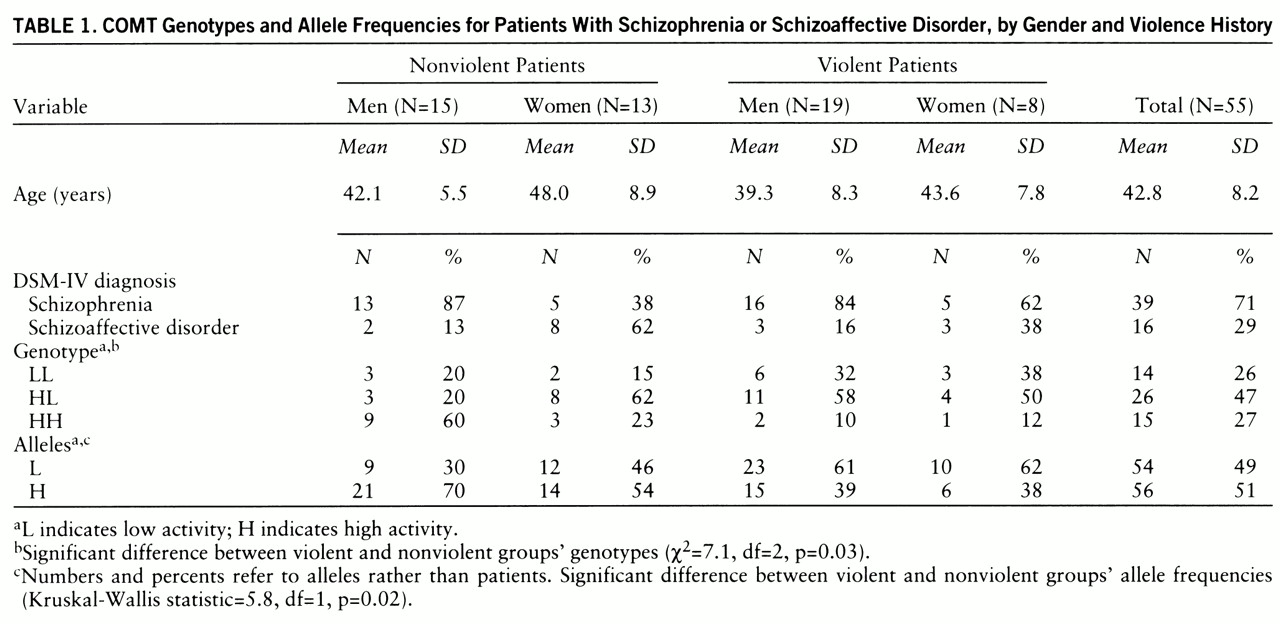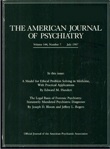Alterations in catecholamines have been implicated in aggressive behavior (
1–
3). Catechol
O-methyltransferase (COMT) inactivates catecholamines (
4) and therefore could be a factor in regulating aggressive behavior. A common polymorphism in the COMT gene, at codon 158, results in a valine to methionine substitution and is associated with threefold to fourfold differences in COMT activity between homozygous subjects; heterozygous subjects have intermediate levels of activity (
5–
9).
The methionine encoding, low-activity allele may be involved in obsessive-compulsive disorder (
10) and rapid cycling bipolar disorder in velo-cardio-facial syndrome, a congenital anomaly associated with chromosome 22q11.2 deletions (
11). Although we did not find an association between COMT genotype and schizophrenia, an association between the low-activity allele and greater violent behavior in schizophrenic patients was detected (
12,
13).
This study was intended to replicate and extend the finding relating COMT genotype and aggression through use of more direct measures of violent behavior.
METHOD
Fifty-five white patients (34 men and 21 women, including two nonblack Hispanics) with DSM-IV diagnoses of schizophrenia (N=39) or schizoaffective disorder (N=16) were recruited from Rockland Psychiatric Center (N=48) and Bronx Psychiatric Center (N=7). Written informed consent was obtained from all subjects. Most were inpatients (N=42) or residents in community care facilities (N=8). All had at least one prior inpatient psychiatric hospitalization. Violence classification was based on review of all available material (admission and discharge summaries, progress notes, treatment plans of current and prior hospitalizations, and, for inpatients, chart notes transcribed from official records of arrests and convictions provided by the New York State Bureau of Criminal Justice Services). Violent subjects had a documented history of multiple assaults. Assault was defined as an attack on another person, including hitting, kicking, slapping, biting, choking, throwing objects, and using weapons. Comparison subjects had no known history of violent or threatening behavior. Subjects showing intermediate levels of violence, such as single assault, verbal threats, or gestures, were not included in the study.
The COMT codon 158 polymorphism was determined by restriction fragment length polymorphism analysis through use of polymerase chain reaction amplified gene fragments and Nla III restriction digestion, as previously described in detail (
9). Genotyping was performed by individuals who were blind to violence histories.
Chi-square analyses were applied to 3 by 2 (genotype by subject group) tables. Kruskal-Wallis analyses were applied to allele frequency distributions.
RESULTS
The nonviolent and violent groups were not significantly different in age (F=3.9, df=1,53, p=0.05) or diagnosis (χ
2=1.2, df=1, p=0.27) (
table 1). The association between COMT genotype and violence was significant (p=0.03), as were between-group differences in allele frequencies (p=0.02). Sixty-four percent of patients homo~zygous for the low-activity COMT allele (LL genotype) were violent; 80% of patients homozygous for the high-activity allele (HH genotype) were nonviolent.
The significant between-group differences were due primarily to the male patients (genotype: χ2=9.7, df=2, p=0.008; allele frequency: Kruskal-Wallis statistic=5.4, df=1, p=0.02). The results were not significant in female patients (genotype: χ2=1.42, df=2, p=0.49; allele frequency: Kruskal-Wallis statistic=1.2, df=1, p=0.27). However, the group size was relatively small, and the proportion of schizoaffective subjects was greater among women.
DISCUSSION
This study replicates our previous report of an association between COMT genotype and aggression in schizophrenic subjects (
13). The low-activity COMT allele appears to increase the propensity for violent behavior, whereas the high-activity allele may have a protective effect. The findings support other studies showing that alterations in catecholamine transmission play a role in violence (
1–
3,
14–
16). Since this is a replication study, this is likely a true association rather than a false positive result due to population stratification. The possibility of stratification is further diminished by the finding that the frequency of the COMT polymorphism appears to be fairly stable in different Caucasian populations (
7,
17,
18).
These data strongly suggest that the COMT polymorphism, or a gene in linkage disequilibrium with the COMT locus, plays a role in violence in schizophrenia. However, considering that the number of patients in this and our previously published study is relatively small, and that the levels of significance achieved are modest, the findings still have to be replicated by other investigators. In addition, other studies will be needed to determine whether the COMT polymorphism plays a role in violence in the general population.


